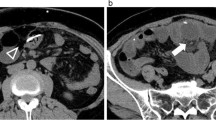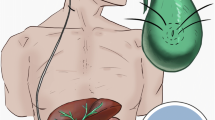Abstract
Introduction
Ventriculo-gallbladder shunt (VGS) has been recognized as a last-resort alternative to treat hydrocephalus when the peritoneum and/or other distal sites can no longer receive shunts. In some specific conditions, it may be conceded as a first-line treatment.
Case presentation
We report the case of a 6-month-old girl with progressive post-hemorrhagic hydrocephalus who presented a concomitant chronic abdominal symptom. Specific investigations ruled out acute infection and led to the diagnosis of chronic appendicitis. Both problems were managed in a one-stage salvage procedure consisting of laparotomy sanctioning to treat the abdominal pathology and seize the opportunity to perform a VGS as a first option since the abdomen is prone to ventriculoperitoneal shunt (VPS) failure.
Conclusion
Only few cases have reported the use of VGS as the first option to handle uncommon complex cases due to abdominal or cerebrospinal fluid (CSF) conditions. We wish to draw attention to VGS as an effective procedure not only in children with multiple shunt failures but also as first-line management in some selected cases.



Similar content being viewed by others
Availability of data and material
Not applicable.
References
Smith GW, Moretz WH, Pritchard WL (1958) Ventriculo-biliary shunt; a new treatment for hydrocephalus. Surg Forum 9:701–705
Aldana PR, James HE, Postlethwait RA (2008) Ventriculogallbladder shunts in pediatric patients. J Neurosurg Pediatr 1:284–287. https://doi.org/10.3171/PED/2008/1/5/284
Ketoff JA, Klein RL, Maukkassa KF (1997) Ventricular cholecystic shunts in children. J Pediatr Surg 32:181–183. https://doi.org/10.1016/s0022-3468(97)90175-5
Pal K, Jindal V (2007) Ventriculo cholecystic shunt in the management of hydrocephalus. Indian Pediatr 44:435–437
Pancucci G, Plaza-Ramirez E, Driller C, Miranda-Lloret P, Botella-Asunción C (2019) Laparoscopy-assisted placement of a ventriculobiliary shunt: a technical note. Childs Nerv Syst ChNS Off J Int Soc Pediatr Neurosurg 35:1397–1400. https://doi.org/10.1007/s00381-019-04173-5
West KW, Turner MK, Vane DW, Boaz J, Kalsbeck J, Grosfeld JL (1987) Ventricular gallbladder shunts: an alternative procedure in hydrocephalus. J Pediatr Surg 22:609–612. https://doi.org/10.1016/s0022-3468(87)80110-0
Gil Z, Beni-Adani L, Siomin V, Nagar H, Dvir R, Constantini S (2001) Ascites following ventriculoperitoneal shunting in children with chiasmatic-hypothalamic glioma. Childs Nerv Syst ChNS Off J Int Soc Pediatr Neurosurg 17:395–398. https://doi.org/10.1007/s003810100460
Olavarria G, Reitman AJ, Goldman S, Tomita T (2005) Post-shunt ascites in infants with optic chiasmal hypothalamic astrocytoma: role of ventricular gallbladder shunt. Childs Nerv Syst ChNS Off J Int Soc Pediatr Neurosurg 21:382–384. https://doi.org/10.1007/s00381-004-0996-1
West GA, Berger MS, Geyer JR (1994) Childhood optic pathway tumors associated with ascites following ventriculoperitoneal shunt placement. Pediatr Neurosurg 21:254–258; discussion 259. https://doi.org/10.1159/000120846
Ignacio RC, Schermerhorn SMV, Marrotte AJ, Prieto JM (2019) Laparoscopic ventricular-cholecystic shunt. J Pediatr Surg Case Rep 47:101233. https://doi.org/10.1016/j.epsc.2019.101233
Frim DM, Lathrop D, Chwals WJ (2001) Intraventricular pressure dynamics in ventriculocholecystic shunting: a telemetric study. Pediatr Neurosurg 34:73–76. https://doi.org/10.1159/000055998
Lyngdoh BT, Islam MS (2012) Ventriculocholecysto shunt: a solution to recurrent shunt complications in comorbid post-tubercular hydrocephalus with tubercular adhesive peritonitis. Acta Neurochir (Wien) 154:2267–2270. https://doi.org/10.1007/s00701-012-1506-y
Rivero-Garvía M, Pancucci G, Morcillo J, Millán A, Márquez-Rivas J (2015) Ventriculobiliary shunts, another option. Pediatr Neurosurg 50:152–156. https://doi.org/10.1159/000381030
Alraee S, Alshowmer S, Alnamshan M, Azzubi M (2020) Management of ventriculo-gallbladder shunt in the presence of gallstones. BMJ Case Rep 13:e234775. https://doi.org/10.1136/bcr-2020-234775
Barami K, Sood S, Ham S, Canady A (1998) Chemical meningitis from bile reflux in a lumbar-gallbladder shunt. Pediatr Neurosurg 29:328–330. https://doi.org/10.1159/000028748
Fountas KN, Kassam MA, Grigorian AA (2007) A rare, delayed complication of a ventriculogallbladder shunt. Case report and review of the literature. Neurosurg Focus 22:E12. https://doi.org/10.3171/foc.2007.22.4.14
Henderson D, Budu A, Horridge M, Jesurasa A, Sinha S, Ushewokunze S, Fisher R (2019) The ventriculo-cholecystic shunt: does CSF volume matter? Childs Nerv Syst ChNS Off J Int Soc Pediatr Neurosurg 35:1557–1560. https://doi.org/10.1007/s00381-019-04317-7
Kulwin CG, Margaron FC, Leys CM, Boaz JC, Fulkerson DH (2014) Ventriculogallbladder shunt fracture: bile peritonitis. J Neurosurg Pediatr 13:94. https://doi.org/10.3171/2013.10.PEDS13289
Morosanu CO, Priscu A, Florian IS (2021) Evaluation of the ventriculocholecystic shunt-an overview of present practice in adult and pediatric hydrocephalus. Neurosurg Rev 44:2533–2543. https://doi.org/10.1007/s10143-021-01472-x
Scaife M, Abegglen R, Vila C, Stahlfeld K (2018) Abnormal presentation of ascending cholangitis. Clin Case Rep 6:1172–1173. https://doi.org/10.1002/ccr3.1357
Surfield GA, Klein RL (2006) Case report of symptomatic cholelithiasis after ventricular cholecystic shunt. J Pediatr Surg 41:1933–1934. https://doi.org/10.1016/j.jpedsurg.2006.07.017
Pierro A, Manalang LR, May PL, Cooke RW, Cudmore RE, Lloyd DA (1993) Necrotizing enterocolitis complicating the management of posthemorrhagic hydrocephalus. J Pediatr Surg 28:982–985. https://doi.org/10.1016/0022-3468(93)90497-9
Reisner A, Smith AD, Wrubel DM, Buster BE, Sawvel MS, Blackwell LS, Laxpati NG, Brahma B, Chern JJ (2021) Utility of ventriculogallbladder shunts in complex cases of hydrocephalus related to extreme prematurity. J Neurosurg Pediatr 27:511–517. https://doi.org/10.3171/2020.9.PEDS20522
Adegbite AB, Khan M (1982) Role of protein content in CSF ascites following ventriculoperitoneal shunting. Case report J Neurosurg 57:423–425. https://doi.org/10.3171/jns.1982.57.3.0423
Demetriades AK, Haq IZ, Jarosz J, McCormick D, Bassi S (2013) The ventriculocholecystic shunt: two case reports and a review of the literature. Br J Neurosurg 27:505–508. https://doi.org/10.3109/02688697.2013.771135
Parikh P, Carratola MC, Malik T (2013) Removal of a retained fragment of a ventriculo-gallbladder shunt in the common bile duct. Eur J Surg Sci 4(3):126. https://corescholar.libraries.wright.edu/surg/169
Author information
Authors and Affiliations
Contributions
MH: conceptualization. ZS: writing—original draft and editing. MB: review and editing. SM: review of literature. AB: methodology. MD: supervision. All authors read and approved the final manuscript.
Corresponding author
Ethics declarations
Ethics approval and consent to participate
Not applicable.
Consent for publication
Informed consent was obtained from a relative for the publication of this case report and accompanying images.
Conflict of interest
The authors declare that they have no competing interests.
Additional information
Publisher's Note
Springer Nature remains neutral with regard to jurisdictional claims in published maps and institutional affiliations.
Rights and permissions
Springer Nature or its licensor (e.g. a society or other partner) holds exclusive rights to this article under a publishing agreement with the author(s) or other rightsholder(s); author self-archiving of the accepted manuscript version of this article is solely governed by the terms of such publishing agreement and applicable law.
About this article
Cite this article
Hadhri, M.M., Souei, Z., Boukhit, M. et al. Can we consider ventriculo-gallbladder shunt a first-line treatment in selected patients? Case report of a successful management. Childs Nerv Syst 39, 1963–1968 (2023). https://doi.org/10.1007/s00381-023-05923-2
Received:
Accepted:
Published:
Issue Date:
DOI: https://doi.org/10.1007/s00381-023-05923-2




